Novavax, a little-known company supported by the U.S. federal government’s Operation Warp Speed, said for the first time on Thursday that its Covid-19 vaccine offered robust protection against the virus. But it also found that the vaccine is not as effective against the fast-spreading variant first discovered in South Africa, another setback in the global race to end a pandemic that has already killed more than 2.1 million people.
The news was problematic for the United States, which hours earlier reported its first known cases of the contagious variant in two unrelated people in South Carolina. And it came just days after Moderna and Pfizer said that their vaccines were also less effective against the same variant.
Novavax, which makes one of six vaccine candidates supported by Operation Warp Speed last summer, has been running trials in Britain, South Africa, the United States and Mexico. It said Thursday that an early analysis of its 15,000-person trial in Britain revealed that the two-dose vaccine had an efficacy rate of nearly 90 percent there. But in a small trial in South Africa, the efficacy rate dropped to just under 50 percent. Almost all the cases that scientists have analyzed there so far were caused by the variant, known as B.1.351. The data also showed that many trial participants were infected with the variant even after they had already had Covid-19.
“We have the first trial — we are the first to conduct an efficacy trial — in the face of a changing virus,” said Stanley Erck, the president and chief executive of Novavax. He said that researchers expected the variants could change the trial results, but “the amount of change has been a bit of a surprise to everyone.”
The South Africa trial was relatively small — with just 4,400 volunteers — and was not designed to come up with a precise estimate of how much protection the vaccine provides. Still, the results were striking enough that the company said it would soon begin testing a new vaccine tailored to protect against the variant from South Africa. “You’re going to have to make new vaccines,” Mr. Erck said.
While the Pfizer and Moderna vaccines rely on a newer mRNA technology that has not been used in previous vaccines, Novavax’s candidate employs an older, more established method that relies on injecting coronavirus proteins to provoke an immune response.
The fact that three vaccines all appeared to show lowered effectiveness against the variant from South Africa is not encouraging, and the results Novavax announced Thursday were the first to occur outside of a laboratory, testing how well a vaccine worked in people infected with a new variant. Johnson & Johnson is also on the cusp of announcing results of its Covid-19 vaccine trials, and has also tested its candidate in South Africa.
The announcement from Novavax raises the stakes for Johnson & Johnson. The company was expected to announce its results as early as last weekend, and the delay has triggered speculation among scientists that the firm has also discovered that its vaccine worked less well in South African trial volunteers who were infected with the variant. In an earnings call on Tuesday, Alex Gorsky, the chief executive officer of the company, said they were looking forward to sharing results from their late-stage trial by early next week.
The emergence of several highly contagious variants has complicated efforts to bring the pandemic under control, leading world leaders to shut down travel to places like Britain and South Africa even as the variants already appear to have circled the globe. In the United States, researchers have warned that the variant first identified in Britain, which is believed to be more infectious, could become the dominant form of the virus in this country by March.
The United States is well behind other countries in testing for such variants, and the one from South Africa has been found in about 30 countries.
But experts have also said there are reasons for optimism, noting that the vaccines remain effective. The best way to combat contagious new variants is to continue vaccination and other public health measures, which will slow the virus’s ability to infect new people and mutate further. Drug makers could update their vaccines and offer new shots at regular intervals, similar to the flu vaccine.
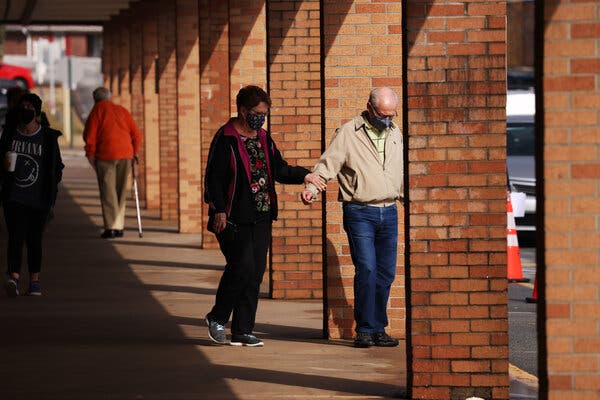
Health officials in South Carolina said on Thursday that they had detected two cases of a more contagious variant of the coronavirus that emerged in South Africa. It was the first report of that variant being detected in the United States.
The South Carolina Department of Health and Environmental Control said it had identified one case on Wednesday, and was notified of a second case the same day by the Centers for Disease Control and Prevention. The variant, known as B.1.351, was originally identified in South Africa and has since been found in about 30 countries.
The United States is conducting little of the genomic sequencing necessary to track the spread of new variants that have caused concern. They include B.1.1.7, first found in Britain and since seen in more than 46 countries and 24 U.S. states, and the P.1 variant, first found in Brazil, which officials in the United States reported detecting this week in Minnesota.
While the two coronavirus vaccines now in use in the United States, developed by Moderna and Pfizer-BioNTech, appear to be protective against the new variants, they may be somewhat less effective against the one found in South Africa. Moderna has begun developing a new form of its vaccine that could be used as a booster shot against the variant in South Africa. The new variants are also believed to spread more readily than other versions of the virus, and the one found in Britain may lead to more severe disease.
But a little-known company, Novavax, which has been supported by the U.S. federal government’s Operation Warp Speed program, said for the first time on Thursday that its Covid-19 vaccine, offered robust protection against the virus. But it also found that the vaccine is not as effective against the fast-spreading variant first discovered in South Africa, another setback in the global race to end a pandemic that has already killed more than 2.1 million people.
As of Thursday afternoon, the Centers for Disease Control and Prevention said about 21.7 million people have received at least one dose of a Covid-19 vaccine, and that about 4.3 million people have been fully vaccinated.
The statement from South Carolina’s health department said that the cases involved no known travel to South Africa and no connection between the two patients, both adults, suggesting that the variant is circulating in the community. One patient was in the southern Lowcountry region of the state, and the other in the Pee Dee region in the northeast.
“The arrival of the SARS-CoV-2 variant in our state is an important reminder to all South Carolinians that the fight against this deadly virus is far from over,” Dr. Brannon Traxler, the department’s interim public health director, said in a statement. “While more Covid-19 vaccines are on the way, supplies are still limited. Every one of us must recommit to the fight by recognizing that we are all on the front lines now.”
At an online briefing, Dr. Traxler said that the same precautions were being taken for the new variant as for other virus cases. Both of the people who contracted the variant were tested in early January and have recovered, she said.
Gov. Henry McMaster wrote on Twitter that the announcement was “important information for South Carolinians to have, but it isn’t a reason for panic” and encouraged residents to wear masks and socially distance.
The C.D.C. said in a statement on Thursday that it was aware of South Carolina’s finding and that it would work to increase genomic sequencing across the country to track virus variants. The agency reiterated its warning against travel at this time.
Starting in March, Britain created an intensive program to track the genetic evolution of the coronavirus, and has sequenced more than 200,000 coronavirus genomes so far — nearly two-thirds of all the ones sequenced in the world. That success is probably why it became the first country to identify the B.1.1.7 virus, in December.
President Biden’s coronavirus czar, Jeffrey D. Zients, said on Wednesday that the United States was woefully behind other nations in tracking the variants, and he used the first White House public health briefing to issue a stark warning that Americans will remain vulnerable to the deadly pandemic unless Congress acts.
On Monday, Mr. Biden issued a ban on noncitizens entering the United States if they have been in South Africa within 14 days, because of concern over the variant. It will go into effect on Saturday. American citizens and permanent residents are not affected, officials said.Asked about the timing of the order at a briefing on Thursday, Jen Psaki, the White House press secretary, said that it took some time to work with airlines and regulatory authorities to put restrictions in place.
“We did that as quickly as possible,” she said.
The administration has also extended bans on travel from Brazil and much of Europe, and imposed a new rule requiring proof of a recent negative virus test before travelers can enter the country.
The B.1.351 variant is predominant in South Africa now, and is driving up new case reports to record levels there and across sub-Saharan Africa, the World Health Organization said on Thursday.
“The variant, which was first detected in South Africa, has spread quickly beyond Africa, and so what’s keeping me awake at night right now is that it’s very likely circulating in a number of African countries,” Dr. Matshidiso Moeti, the W.H.O.’s regional director for Africa, said at a briefing.
Marc Santora contributed reporting.
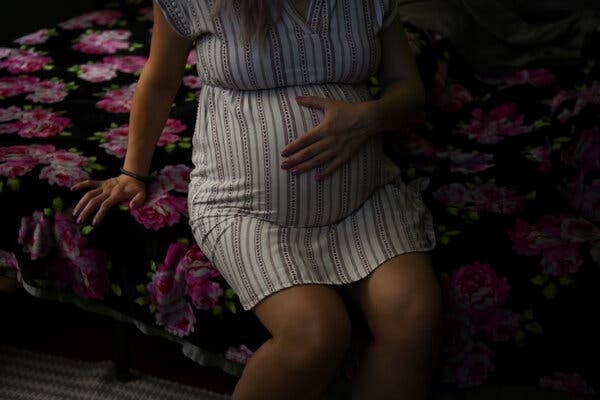
Pregnant women looking for guidance on Covid-19 vaccines are facing confusion of the sort that has dogged the pandemic from the start: The world’s leading public health organizations — the U.S. Centers for Disease Control and Prevention and the World Health Organization — are offering contradictory advice.
The C.D.C.’s advisory committee urged pregnant women to consult with their doctors before rolling up their sleeves — a decision applauded by several women’s health organizations because it kept decision-making in the hands of the expecting mothers.
But the W.H.O. is recommending that pregnant women not receive the vaccines, unless they are at high risk from Covid-19 because of work exposures or chronic conditions. It issued guidance on the Moderna vaccine on Tuesday, stirring uncertainty among women and doctors on social media. (Earlier this month, it had published similar guidance on the Pfizer-BioNTech vaccine.)
Several experts expressed dismay at the W.H.O.’s stance, saying the risks to pregnant women from Covid were far greater than any theoretical harm from the vaccines.
“There are no documented risks to the fetus, there’s no theoretical risks, there’s no risk in animal studies,” from the vaccines, said Dr. Anne Lyerly, a bioethicist at the University of North Carolina, Chapel Hill.
The difference of opinion between the C.D.C. and the W.H.O. is not rooted in scientific evidence, but the lack of it: Pregnant women have been barred from participating in clinical trials of the vaccines, reflecting a long tradition of excluding pregnant women from biomedical research and one that is now being challenged.
While the rationale is ostensibly to protect women and their unborn children, prohibiting pregnant women from studies pushes the risk out of the carefully controlled environment of a clinical trial and into the real world.
Vaccines are generally considered to be safe, and pregnant women have been urged to be immunized for influenza and other diseases since the 1960s, even in the absence of rigorous clinical trials to test them.
“As obstetricians we are often faced with difficult decisions about using interventions in pregnancy that have not been properly tested in pregnancy,” said Dr. Denise Jamieson, an obstetrician at Emory University in Atlanta and a member of the Covid expert group at the American College of Obstetrics and Gynecology. The college strongly advocated including pregnant and breastfeeding women in the vaccine trials.
In a statement, the C.D.C. said on Thursday that based on how the Pfizer-BioNTech and Moderna vaccines work, “they are unlikely to pose a specific risk for pregnant women.”
The C.D.C.’s recommendation may make sense for the United States, where women may easily be able to consult with their health care providers, said Joachim Hombach, a health adviser to the W.H.O. on immunizations. But the W.H.O. provides guidance to many low and middle income countries where women do not have access to doctors or nurses, he said.
The W.H.O.’s recommendation was also made “in the context of limited supply” of the vaccines, Dr. Hombach said. “I don’t think the language is discouraging, but the language is stating the facts.”
Pfizer plans to begin a clinical study in pregnant women in the first half of 2021. Moderna said it was establishing a registry to record outcomes in pregnant women who receive its vaccine.
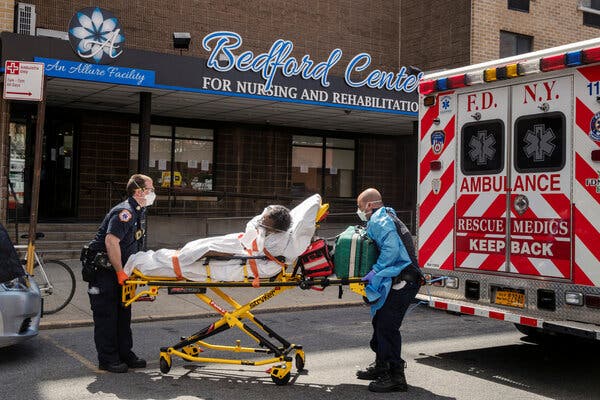
An investigation by the New York State attorney general has concluded that Gov. Andrew M. Cuomo’s administration undercounted coronavirus-related deaths at nursing homes by as much as 50 percent.
The count of deaths in state nursing homes has been a source of controversy for Mr. Cuomo and state Health Department officials, who have been sensitive to any suggestion that decisions made at the outset of the pandemic may have caused some of those deaths, which the state puts at more than 8,700.
They have also been accused of obscuring a more accurate estimate of nursing home deaths, because the state only counted deaths at the actual facilities, rather than including deaths of residents who were transferred to a hospital and died there.
In the 76-page report released on Thursday by the attorney general, Letitia James, a survey of nursing homes found consistent discrepancies between deaths reported to the attorney general’s investigators and those reported to and officially released by the Health Department.
In one instance, an unnamed facility reported to the Health Department that it had 11 confirmed and presumed deaths on site through early August. The attorney general’s survey of that same facility, however, found 40 deaths, including 27 at the home and 13 in hospitals.
Another facility reported one confirmed and six presumed Covid-19 deaths to the Health Department, according to the report. The attorney general’s office, however, said the facility reported to its investigators that there were more than four times that number — 31 dead — by mid-April.
Deaths in nursing homes and other long-term care facilities have accounted for about a third of the nation’s some 430,000 deaths. Federal and state authorities have made vaccinating staff and residents at such facilities a top priority, though that effort has been slower than hoped.
In New York, where there have been more than 42,000 virus-related deaths, the toll in the state’s nursing homes has been a particular source of agony for residents and their families. It has also been a political liability for Mr. Cuomo, who has pushed back on accusations that his administration did not do enough to safeguard a highly vulnerable population.
The findings of Ms. James would seem to put her in rare conflict with Mr. Cuomo, the state’s three-term Democratic incumbent. Ms. James was the governor’s favored choice to succeed Eric T. Schneiderman after he suddenly resigned as attorney general in 2018; she readily embraced Mr. Cuomo’s political backing.
The attorney general asked 62 nursing homes — about a tenth of the state’s total — for information about on-site and in-hospital deaths related to the virus; investigators then cross-referenced that information with public reports of deaths issued by the Health Department. The deaths reported to the attorney general’s office at most of those facilities totaled 1,914, compared to the state’s much lower count of 1,229.
Ms. James said that her office was investigating those circumstances “where the discrepancies cannot reasonably be accounted for by error or the difference in the question posed.”
The attorney general said she was continuing to conduct investigations of more than 20 nursing homes across the state that “presented particular concern,” noting that “other law enforcement agencies also have ongoing investigations relating to nursing homes.”
transcript
transcript
E.U. Pushes for AstraZeneca to Provide More Vaccines
The European Union is pushing for AstraZeneca to supply more doses of its Covid-19 vaccine after announcing on Wednesday that it would cut deliveries by 60 percent due to manufacturing issues.
-
Not being able to ensure manufacturing capacity is against the letter and the spirit of our agreement. We reject the logic of first come, first served. That may work at the neighborhood butcher’s, but not in contracts, and not in our advanced purchase agreements. There’s no priority clause in the advance purchase agreement, and also there’s also no hierarchy of the full production plants named in the advance purchase agreement. In the contracts, there are four, I think, four factories listed, but it does not differentiate between the U.K. and the Europe — the U.K. factories are part of our advance purchase agreements, and this is why they have to deliver. Pharmaceutical companies, vaccine developers have moral, societal and contractual responsibilities, which they need to uphold. The view that the company is not obliged to deliver because we signed a best effort agreement is neither correct nor is it acceptable.
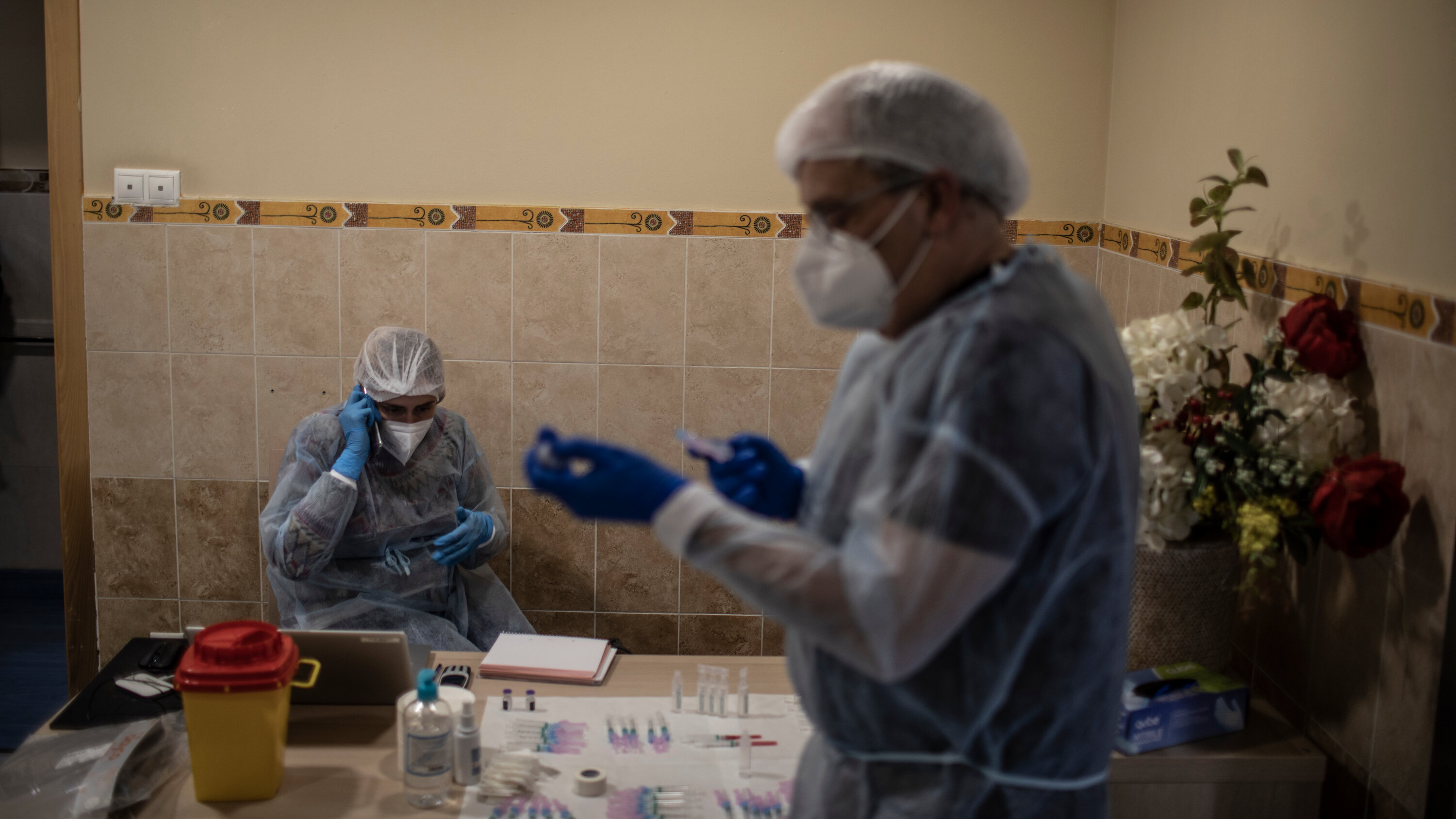
“Tomorrow our fridges will be empty.”
That warning came from Josep Maria Argimon, a health official in Catalonia, and he was referring not to food but to the dwindling supplies of something almost as precious: the coronavirus vaccine.
On Wednesday, Spain became the first European country to partly suspend immunizations because of a lack of doses. It did so first in Madrid, for two weeks, and said that Catalonia, the northeastern region that includes Barcelona, could soon follow.
It has not gone easily for the European Union since it approved its first vaccine in late December and rushed to begin a vast immunization campaign across its 27 member states.
But the early problems have snowballed into a full-blown crisis.
Countries across the bloc have felt the pain of vaccine shortages even as a new wave of the virus rages. The pandemic has prompted prolonged lockdowns in most member countries, and there is also anxiety over the spread of at least two highly infectious variants that are straining national health systems.
It is unclear when the supply might improve.
The bloc is also in an escalating dispute with AstraZeneca over the drug maker’s announcement that it would cut deliveries by 60 percent because of production shortfalls. And Pfizer informed the European Union this month that it had to drastically cut its vaccine deliveries until mid-February while it upgraded its plants to ramp up output, adding to the supply problems.
In a rare bit of good news, the French drug maker Sanofi said on Wednesday that it would help produce more than 100 million doses of the Pfizer-BioNTech vaccine, starting this summer — but those doses will most likely come too late to salvage vaccination plans for the first half of 2021.
When the European Union approved its first vaccine in December, it was already weeks behind nations like the United States and Britain. While it is flush with cash, influence and negotiating heft, the bloc of 27 nations has also found itself lagging countries such as Israel, Canada and the United Arab Emirates.
Last week, the European Union’s executive branch, the European Commission, set a goal of having 70 percent of its population inoculated by this summer. Just days later, the president of the European Council, Charles Michel, pronounced that “difficult.”
As of this week, a mere 2 percent of E.U. citizens had received at least one dose of a coronavirus vaccine, according to numbers collected by the research site Our World in Data. That compares with around 40 percent for Israel, 11 percent for Britain and just over 6 percent for the United States.
Many countries, particularly poorer ones, are struggling to secure any vaccines at all. But the delays in Europe have created tensions.
Some critics have blamed the European Commission, which struck deals on behalf of the member states to secure a total of 2.3 billion vaccine doses from several companies.
Some of its agreements were struck weeks after those reached by the United States and Britain. AstraZeneca and some European opposition politicians say that the delay put the bloc at the back of the line for deliveries. The commission has challenged those claims.
“We reject the logic of first-come, first-served,” the bloc’s heath commissioner, Stella Kyriakides, said at a news conference on Wednesday. “That may work at the neighborhood butcher, but not in contracts and not in our advanced purchase agreements.”
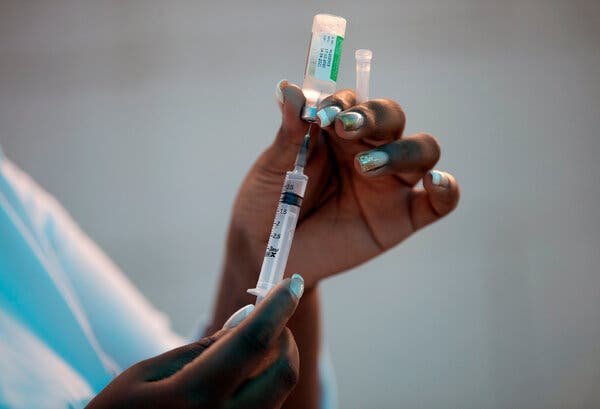
Germany’s vaccination advisory committee, which provides recommendations to the government, is cautioning against using the AstraZeneca shot on adults age 65 and above, saying in a draft report released on Thursday that “there currently is not sufficient data to assess the vaccination effectiveness above 65 years.”
The German Health Ministry, which usually follows the advice of the committee, declined to comment. The European Medicines Agency, the regulatory body for the European Union, is expected to announce on Friday whether the vaccine will be approved for use in the bloc. Britain has been administering the AstraZeneca shots to all age groups after it became the first country to give the vaccine emergency authorization, in December.
British regulators have said that data on the efficacy and safety of the vaccine “are currently limited” in people age 65 and older.
But concerns about the scarce data on older people could limit the use of the AstraZeneca shot: European regulators are considering authorizing it only for people under 65, two E.U. officials said.
Neither AstraZeneca nor Oxford University, which helped develop the vaccine, has released figures on how effective the shot is in older people. But data on older people’s immune responses have suggested that the vaccine will help protect them from the virus, the company has said.
The Oxford team, which was in charge of the earliest trials of the vaccine, did not want to vaccinate older people until they had collected extensive safety data for younger participants, Pascal Soriot, the chief executive of AstraZeneca, said in an interview with La Repubblica, an Italian newspaper, this week.
Other vaccine makers, Mr. Soriot said, decided to vaccinate older people in trials before they had accumulated as much safety data, allowing them to make stronger claims about efficacy in that age group.
In the United States, the Food and Drug Administration is waiting on data from a clinical trial that enrolled about 30,000 participants, mostly Americans, and that will include more older people. The results are expected in the coming weeks. AstraZeneca is expected to have sufficient safety data from that study to file for emergency use authorization from the F.D.A. around the first week of March.
Benjamin Mueller and Rebecca Robbins contributed reporting.
transcript
transcript
Health Care Orders Undo ‘Damage Trump Has Done,’ Biden Says
President Biden took executive action to expand health care access by strengthening the Affordable Care Act and reopening enrollment. He also moved to protect reproductive rights and expand abortion access.
-
Today, we’re about to sign two executive orders. Basically, the best way to describe it, to undo the damage Trump has done. There’s nothing new that we’re doing. The first one I’m going to be signing here is to strengthen Medicaid and the Affordable Care Act. And of all times that we need to reinstate access to affordability of and extent of access to Medicaid, is now, in the middle of this Covid crisis. And the second order I’m signing relates to protecting women’s health at home and abroad, and it reinstates the changes that were made in Title X and other things, making it harder for women to have access to affordable health care as it relates to reproductive rights.
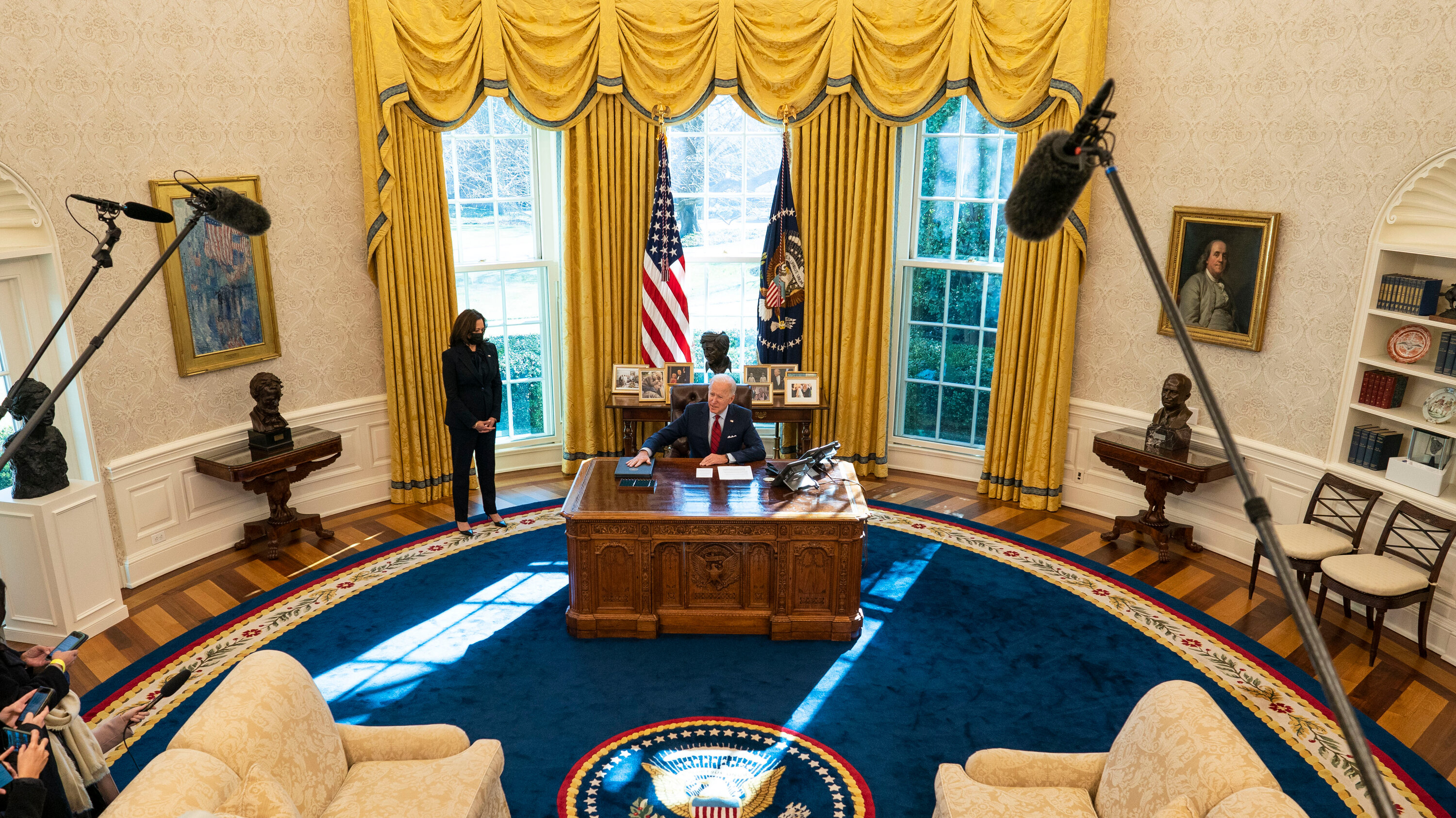
President Biden, seeking to expand access to health care and strengthen the Affordable Care Act, used his executive authority Thursday to order the reopening of enrollment in the health law’s marketplaces and a re-examination of Trump administration policies that undermined protections for people with pre-existing medical conditions.
His aim, he said in a brief signing ceremony in the Oval Office, was to “undo the damage Trump has done.”
Mr. Biden also moved to protect reproductive rights and expand access to abortion, and took separate executive action to overturn his predecessor’s restrictions on the use of taxpayer dollars for clinics that refer or counsel patients to terminate pregnancies, both in the United States and overseas.
Taken together, Mr. Biden is trying to put a quick stamp on health policies that have been critical to a Democratic resurgence, especially those that back the Affordable Care Act, which he helped secure as President Barack Obama’s vice president. President Donald J. Trump failed to overturn the health law, but he spent four years undermining it with a series of executive actions, including allowing the sale of cheap, short-term and small-business health plans that do not meet the law’s health coverage mandates.
Mr. Biden’s first step is to reopen enrollment for health coverage offered through the federal marketplace created under the health law, also known as Obamacare. His intent is to offer coverage not only to those who lost it during the pandemic, but also to those who did not have insurance and now want it, according to a senior administration official who previewed the new policy during a conference call Thursday morning.
The so-called special enrollment period will run from Feb. 15 to May 15. The official said the reopening would be accompanied by the kind of robust patient outreach — including “paid advertising, direct outreach to consumers and partnerships” with community organizations and advocacy groups — that was abandoned by the Trump administration.
Typically, Americans in the 36 states that rely on the federal marketplace can buy Obamacare insurance only during a six-week period in the fall, a restriction meant to encourage people to hold coverage even when they are healthy. The sign-up period for this year’s coverage ended in mid-December, with enrollments only slightly higher than they were last year. But the Trump administration did little to advertise it.
Once the coronavirus struck, Mr. Trump faced pressure to reopen enrollment for the millions of Americans losing their jobs, but he refused.
Mr. Biden’s actions take aim at a number of Mr. Trump’s policies. In 2018, citing complaints about the price of Obamacare coverage, the Trump administration issued a rule that extended the length of less expensive “short” term policies from three months to up to three years. Such policies do not have to cover pre-existing conditions and can exclude common benefits like maternity care, mental health care or prescription drugs. The former administration also made it easier for small businesses to band together and offer plans that escape some of the requirements of the Affordable Care Act.
Mr. Biden has asked federal agencies to re-examine these rules, which could take months to undo. Should the rules be overturned, patients who have such policies would be unable to renew them, which could leave them without insurance if they think coverage is too expensive. Mr. Biden campaigned on raising the subsidies for Obamacare plans to make them more affordable.
Mr. Biden’s executive actions on abortion put him in the center of the nation’s long-running culture wars. Like his Democratic predecessors, Presidents Bill Clinton and Barack Obama, he will immediately rescind the global gag rule — often called the “Mexico City Policy” — which bars international nonprofit organizations that provide abortion counseling from using American tax dollars.
The rule has been riding a philosophical seesaw for decades — in place when a Republican occupies the White House, and overturned when a Democrat moves in.
Mr. Biden is also directing the Department of Health and Human Services to “take immediate action,” his administration said, to consider whether to rescind the so-called domestic gag rule — a regulation imposed by the Trump administration that prohibits family planning clinics that receive federal funding from counseling patients about abortion. Such a change would likely require the department to write new regulations, a process that could take months.
The president’s Obamacare directive will also instruct federal agencies to review policies — including waivers that allowed states to impose work requirements — that discourage participation in Medicaid, the public health insurance program for the poor and disabled. Enrollment in Medicaid has grown substantially during the coronavirus pandemic, in part because people who have lost jobs and their health insurance have turned to Medicaid for coverage.

Senior staff members in West Wing offices are prohibited from meeting together in an office for more than a total of 15 minutes in a day, according to a senior Biden administration official. No more than six people are allowed to gather in the Oval Office at a time, and a maximum of five staff members are allowed to meet together in the spacious office of the chief of staff, Ron Klain, the official said.
That means that both the morning and afternoon senior staff meetings in the White House are conducted on video calls, even though many of the participants are working in offices near one another.
In the Roosevelt Room, gatherings are limited to 10 people. And when staff members remove their masks to eat lunch at their desks, they are required to close their doors.
Visitors are not allowed without approval, and West Wing staff members generally do not intermingle with the team working in the Eisenhower Executive Office Building across the street.
As the new administration finds its footing, life in the West Wing has become incredibly disciplined, partly because of the way President Biden’s team wants to work, but mostly because of the strict rules the administration has put in place to prevent the spread of the coronavirus. Unlike an administration functioning during normal times, the Biden team can’t simply add people to a meeting at the last minute, or run someone into the building.
It couldn’t be more different in feel and temperament from the opening weeks of the Trump administration, when the Oval Office was often compared to Grand Central Terminal. Former President Donald J. Trump’s office served as a bustling focal point of all West Wing activity as aides wandered in and out and then simply hung about, once it was clear that there was no formal structure for meetings or policymaking, and that for Mr. Trump, out of sight was out of mind.
All West Wing staff members are still tested daily even though a growing number of administration officials are getting vaccinated. There are also fewer people working in the building, and those who are there rarely leave the campus for lunch. There have been awkward moments in hallways, when staff members don’t recognize each other because everyone is required to wear an N95 mask and many have opted to double-mask, officials said.
The measures are in place because of a realization that while it may be impossible to prevent the coronavirus from entering the White House complex entirely, it is possible to reduce the risk of widespread infection if someone on the president’s team gets sick. The rules have been put in place by Anne Filipic, the director of management and administration, and Jeff Wexler, the White House director of Covid-19 operations.
A White House spokesman would not confirm the number of people allowed in meetings, or the time limits on such gatherings. But he said that in-person meetings were limited and that colleagues were socially distancing.
So far, officials said, the measures appear to be working. But they concede that it’s a difficult way to run a White House, just as it was a difficult way to run a campaign and a difficult way to run a transition.
“Adjusting to doing most meetings via video and doing most of our work with colleagues remotely has not been a massive leap,” said Jen Psaki, the White House press secretary. “It has been a long adjustment as humans to not being able to hug old colleagues or shake hands with new ones, but so far we don’t feel that it has prevented us from doing our jobs.”
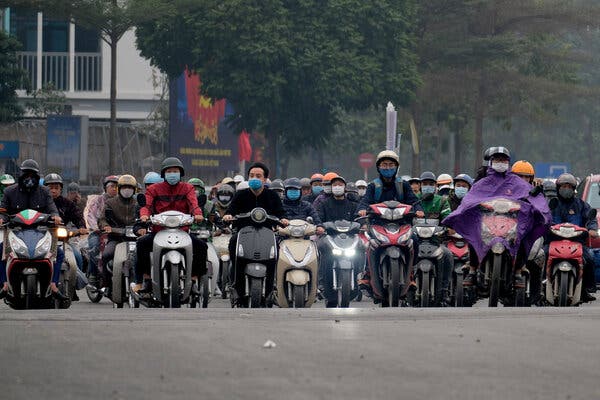
Vietnam reported 82 coronavirus infections on Thursday, the first cases of local transmission in nearly two months, and the government said that some may be connected to the new variant that has been spreading rapidly in Britain.
Prime Minister Nguyen Xuan Phuc has called on the two northern provinces where the cases were reported to close their borders to prevent people from leaving, the state-run news media reported on Thursday.
Vietnam has been relatively successful in containing the virus. Before the latest outbreak in the northern provinces, Hai Duong and Quang Ninh, the country had reported only about 1,550 cases and 35 deaths.
The new cases arrived at an inconvenient time. Officials from the governing Communist Party are meeting this week in Hanoi, the capital, to select their next leaders, an event that takes place once every five years. And people across the country are preparing to celebrate the Lunar New Year, Vietnam’s biggest holiday.
Vietnam’s largest outbreak occurred in July in the central city of Danang, sickening hundreds and causing all 35 of the country’s reported deaths before it was contained.
Health officials initially reported two new cases Thursday morning. But the number rose to 82 by the afternoon, after health workers began tracing and isolating the first patients’ contacts.
Of 138 people tested in Hai Duong, 72 were positive for the virus, Health Minister Nguyen Thanh Long said, according to a recording of comments made at an urgent meeting on the sidelines of the Communist Party congress. All of those patients work at a local electronics factory, local news media reported.
The first worker found to have contracted the virus is said to have had contact with a Vietnamese national who later traveled to Japan, where he tested positive for the variant that has spread in Britain.
The other 10 cases appear to have originated with a worker at Van Don International Airport in Quang Ninh Province who was responsible for taking arriving passengers to quarantine.
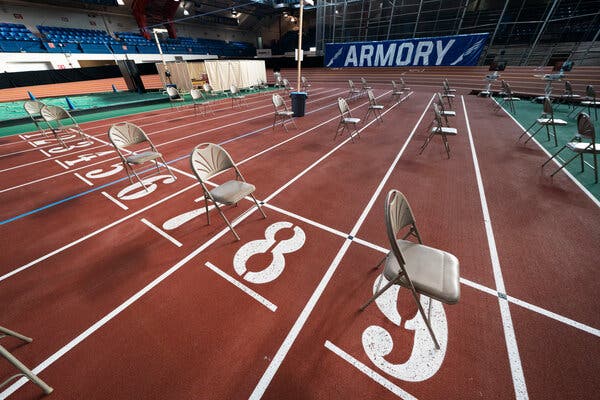
A New York City health network changed its guidelines at a Covid-19 vaccination center in a predominantly Hispanic neighborhood after it was found to have been providing the scarce doses to suburbanites while local residents struggled to get appointments.
The health network, New York-Presbyterian, announced Wednesday that it would limit all new vaccine appointments at the center, in Washington Heights, to New York City residents effective immediately. Earlier this month, Gov. Andrew M. Cuomo touted the center as a way to combat inequity and to make sure “New Yorkers of color aren’t left behind.”
Black and Latino people are more likely to be affected by the virus than white people, and many minority communities have been suspicious of taking the vaccine in light of the history of unethical medical research in the United States. Officials have stressed the importance of making vaccines accessible to underserved communities.
However, a report this week by The City, a nonprofit news organization, found that no guides or guards at the center spoke Spanish, despite its location. Many patients entering the site “appeared to be white and unfamiliar with the neighborhood,” The City reported.
Until Wednesday, the center provided vaccinations to any patients who were eligible for the vaccine as long as they had an appointment. Now, a minimum of 60 percent of the appointment slots will be reserved for residents of Washington Heights and nearby neighborhoods in Manhattan and the South Bronx, according to the statement from New York-Presbyterian. (All existing appointments scheduled before Wednesday would still be honored.)
The health network added that “a dedicated outreach team that includes bilingual staff has been created to expand community outreach efforts in Northern Manhattan.”
At a news conference on Thursday, Mayor Bill de Blasio expressed frustration over the vaccine rollout at the center.
“What happened in Washington Heights is the exact opposite of what we need,” he said. “If a site is in a community, particularly a community hard hit by Covid, it should be all about reaching out to that community and bringing people in.”
Mr. de Blasio said that there had been 699,524 doses of vaccine administered in the city, but a shortage in the available supply was still slowing the vaccination effort.
He said the state had made available to the broader eligible population in the city some 18,000 doses that were slated for use in long-term care facilities, like nursing homes, but were not being used.
City and state officials have said that vaccinations would not be enough to end the pandemic. Mr. de Blasio said that the seven-day average rate of citywide positive test results was 8.09 percent, and had been trending downward over the past week. Still, 34 ZIP codes across the city had a seven-day average positive test rate at or over 10 percent, according to the most recently available data.
While Mr. Cuomo had said on Wednesday that the state was considering allowing indoor dining in the city to resume at 25 percent capacity, Mr. de Blasio on Thursday urged caution, particularly with the danger posed by new variants.
But he said he would be willing to eat indoors if the state allowed it.
“We all want to see indoor dining come back,” Mr. de Blasio said. “It has to be governed by the data and the science. The state will make that decision.”
Global roundup
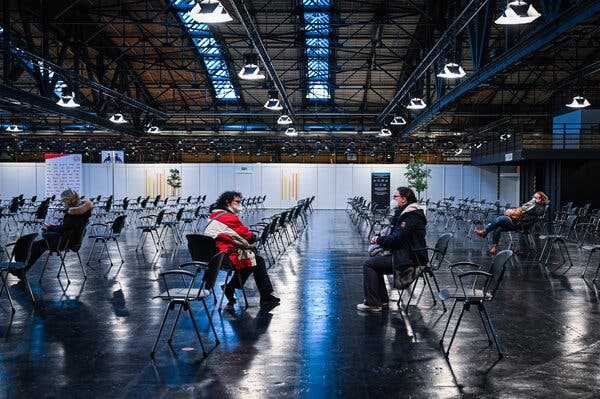
Chancellor Angela Merkel will convene the governors of Germany’s 16 states, along with representatives of pharmaceutical companies to discuss the country’s troubled vaccination scheme, after her health minister, Jens Spahn, warned that the country is facing another 10 weeks of vaccine shortages.
The situation has increasingly angered Germans who were promised an efficient immunization campaign. Even the most vulnerable have struggled to get access to the potentially lifesaving shots.
The German government helped fund development of the Pfizer-BioNTech vaccine with 738 million euros, or about $895 million, only to see it first administered in Britain. But many immunization centers set up across Germany stand empty, and older adults who were to be among the first to be vaccinated have been turned away.
“We are facing at least 10 hard weeks, given the lack of vaccines,” Mr. Spahn said on Twitter on Thursday.
Instead of approving and purchasing vaccine doses on its own, Germany chose to band together with 26 other European Union countries to ensure equal access across the bloc. But the process has been slowed by squabbling between members over sluggish vaccine production. This week, it became further bogged down by a dispute with the British-Swedish pharmaceutical maker AstraZeneca, after the company announced that it would not be able to meet its delivery quotas to the European Union.
In other news from around the world:
-
In the Philippines, the Food and Drug Administration granted emergency approval on Thursday to the AstraZeneca vaccine, saying that it was 70 percent effective after the first of two doses. The country has reported more than 500,000 cases and 10,000 deaths during the pandemic, second only to Indonesia in Southeast Asia. It has signed a deal with AstraZeneca for 17 million doses, with the first expected to arrive in May.
-
Hundreds of tennis players, coaches and officials who had traveled to Melbourne for the Australian Open were scheduled to begin exiting quarantine on Thursday after spending two weeks in a biosecurity hub. They were forced into a hard lockdown after people on their chartered flights tested positive for coronavirus. There are currently five active coronavirus cases connected to the Australian Open, according to the government agency overseeing the quarantine.
-
Japan’s national broadcaster reported on Thursday that the International Swimming Federation, known as FINA, planned to postpone its artistic-swimming qualification event for the Tokyo Olympics because of the coronavirus. The competition, which was to be held at the Tokyo Aquatics Center in March, would have been the first test event for the reorganized Summer Games. It was rescheduled for May.
-
A businessman from Taiwan has been fined more than $35,000 after he was caught on camera repeatedly breaking rules requiring him to quarantine at home. The man, who returned to Taiwan last week from mainland China, left his home seven times when he was supposed to be in isolation, according to officials in the city of Taichung, where he lives. Taiwan has some of the strictest quarantine rules in the world, a critical part of its success in fighting the virus, and the government routinely punishes and shames people found to be violating regulations. “This misbehavior was serious and must be punished heavily,” Lu Shiow-yen, the mayor of Taichung, said at a news conference this week.
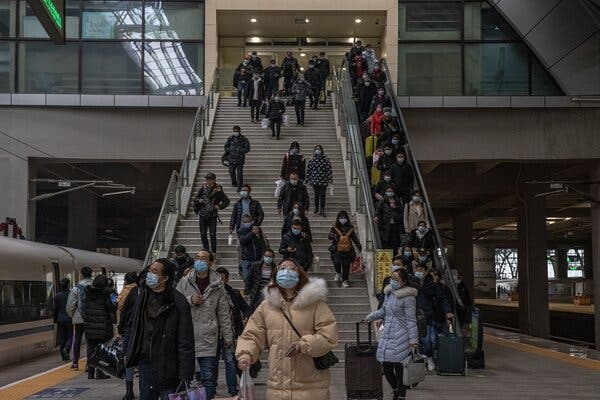
Every winter, Pang Qingguo, a fruit seller in northern China, makes the 800-mile trip to his ancestral home to celebrate the Lunar New Year, the biggest holiday of the year in China, with his family.
The coronavirus ruined the festivities last year, stranding Mr. Pang in the northern city of Tangshan as many Chinese cities imposed lockdowns. Now, as China confronts a resurgence of the virus, the pandemic is set to spoil the holiday again, with the authorities announcing onerous quarantine and testing rules to dissuade migrant workers like Mr. Pang from traveling for the new year, which begins this year on Feb. 12.
Mr. Pang, who describes his home in the northeastern province of Heilongjiang as the “happiest place,” is anguished by the rules. He has taken to social media in recent days to express frustration about his situation and post photographs of his 7-year-old daughter, whom he has not seen in more than a year. “Society is so cruel,” he wrote in one post.
Many of China’s roughly 300 million migrant workers face a similar reality as the government tries to avoid a surge in cases during what is typically the busiest travel season of the year.
The authorities have demanded that people visiting rural areas during the holiday spend two weeks in quarantine and pay for their own coronavirus tests. Many migrants, who endure grueling jobs for meager wages in big cities, say those restrictions make it impossible to travel.
The rollout of the rules has drawn widespread criticism in China, with many people calling the approach unfair to migrant workers, who have long been treated as second-class citizens under China’s strict household registration system. The workers have been among the most deeply affected by the pandemic, as the authorities have carried out scattered lockdowns to fight the virus and employers have reduced hours and pay.
In a regular year, hundreds of millions of people travel by plane, train and car to be with their families for the Lunar New Year. The holiday, which typically includes big festive banquets and fireworks, is normally the only time that many workers can return to their hometowns to see loved ones. This year, many are making plans to spend the holiday alone.
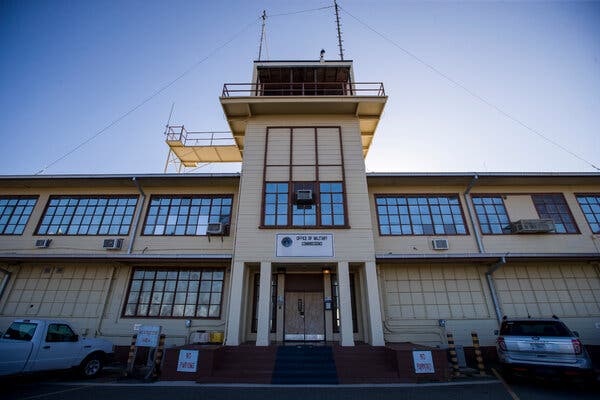
WASHINGTON — The Pentagon has decided to offer coronavirus vaccines to detainees at Guantánamo Bay, Cuba, possibly starting next week, according to a prosecutor in the case against five prisoners accused of conspiring in the attacks of Sept. 11, 2001.
The prosecutor, Clayton G. Trivett Jr., wrote to defense lawyers on Thursday “that an official in the Pentagon has just signed a memo approving the delivery of the Covid-19 vaccine to the detainee population in Guantánamo.”
Medical workers at the U.S. naval base began vaccinating the 6,000 residents on Jan. 8, including the 1,500 troops assigned to the detention operation. But the Trump administration had declined to say whether prisoners would be vaccinated.
The 40 detainees at the prison complex could start receiving the first of the two required doses of vaccine“on a voluntary basis” as soon as Monday, Mr. Trivett said. Under Pentagon policy, because the Food and Drug Administration has given only emergency-use authorization to the Moderna and Pfizer-BioNTech vaccines, the recipient’s consent is required to administer the shots.
It is not known how many people at Guantánamo have been infected with the coronavirus. Early in the pandemic, the military reported two cases there, both believed to be sailors. The Defense Department then halted disclosure of data about specific installations.
Lack of vaccinations has been a major obstacle to resuming war crimes hearings at the base’s Camp Justice compound. It was not immediately known whether the defendants in the Sept. 11 case, including Khalid Shaikh Mohammed, would consent to be vaccinated.
An Army judge has scheduled an arraignment on Feb. 22 for three prisoners accused of conspiring in deadly terrorist attacks in Indonesia in 2002 and 2003. Under the timeline described by Mr. Trivett, prisoners who agree to be vaccinated could receive their second dose on the eve of the arraignment, the first at Guantánamo’s war court since 2014.
The arraignment hearing would be the first court appearance for the three detainees — Encep Nurjaman, who is known as Hambali; Mohammed Nazir Bin Lep; and Mohammed Farik Bin Amin — who have been in U.S. custody since they were captured in Thailand in 2003.
Mr. Hambali, who is Indonesian, is held at Guantánamo as the former leader of Jemaah Islamiyah, a Southeast Asian extremist group that became an Al Qaeda affiliate before the Sept. 11 attacks. The other two men are Malaysians accused of being Mr. Hambali’s accomplices in the 2002 nightclub bombings in Bali, which killed 202 people, and the 2003 Marriott hotel bombing in Jakarta, which killed at least 11 people and wounded at least 80.
Lawyers for several of the detainees said they would need to consult with their clients by letter about whether to consent to be vaccinated.
Dr. Terry Adirim, the Pentagon’s principal deputy assistant secretary of defense for health affairs, signed the memo authorizing the vaccination of the detainees on Wednesday, said Mike Howard, a Pentagon spokesman.
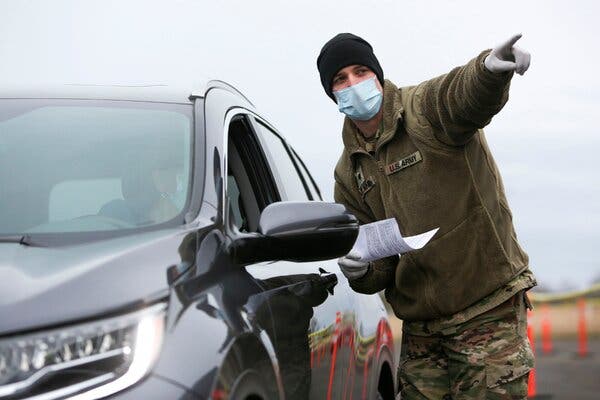
The Pentagon is considering sending active duty troops to large-scale, federally run coronavirus vaccine centers, a major departure for the Department of Defense and the first significant sign that the Biden administration is moving to take more control of a program that states are struggling to manage.
The Federal Emergency Management Agency is hoping to set up roughly 100 vaccine sites nationwide as early as next month, and on Wednesday night requested that the Pentagon support the effort. The sites, and use of the military within them, would require the approval of state governments.
While many governors have turned to their National Guard units to assist with the mass effort to vaccinate Americans and outrace more contagious variants of the coronavirus, the Pentagon’s role has been largely behind the scenes, providing help with logistics.
Using active duty troops for vaccine distribution would demonstrate that the administration’s desire is to take a far bigger role in a task that states are struggling to expedite.
During his confirmation hearings last week, Lloyd J. Austin III, the secretary of defense, said that he would increase military support to help manage the pandemic. On Thursday, Max Rose, Mr. Austin’s senior adviser for Covid-19, said that his first topic of conversation in meetings with senior leaders had been on the topic, establishing that this is Mr. Austin’s number one priority.
Sending troops to help set up sites, assist with logistics and even put shots in arms is something the department is “actively considering,” Mr. Rose said. He declined to provide specific details, saying that Pentagon officials would be reviewing the request from FEMA carefully.
Many states and territories have already set up large vaccination sites, and more than half are using National Guard members to give shots, drawing on doctors, nurses, medics and others skilled in injections. FEMA, an agency within the federal Department of Homeland Security, has already told six states and Washington that it would spend $1 billion on vaccine sites.
It was not immediately clear where the vaccines would come from for new federal sites; they would most likely be supplied by the vaccine supply already given to individual states and territories, most of which have not come close to administering the vaccine they have been given.






